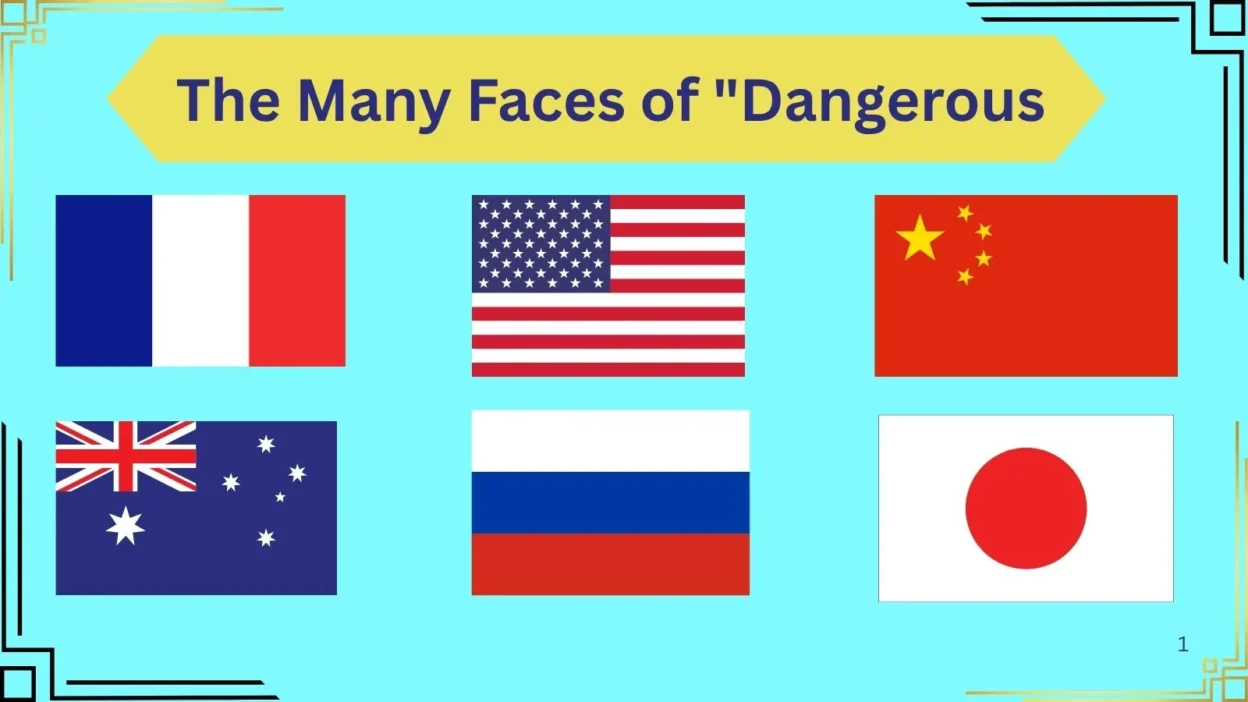If you’re learning English, the word “dangerous” is important to understand because it helps you talk about safety and risk.
“Dangerous” describes something that can cause harm, injury, or trouble — like a dangerous animal, a dangerous road, or a dangerous situation.
Learners sometimes confuse it with words like “scary” or “harmful,” but “dangerous” specifically means that something has the potential to cause real harm.
Knowing how to use this word correctly can help you stay safe and communicate clearly when warning others or describing risky situations.
This list spans 70 languages, revealing how danger is voiced worldwide—through sharp consonants, flowing vowels, or even symbolic scripts. Let’s dive in!
Analysis – Linguistic Patterns & Cultural Nuances

- Etymology & Roots
- Indo-European languages often share roots:
- English “dangerous” (from Old French dangeros)
- Spanish “peligroso” (Latin periculum)
- Russian “опасный” (opasnyy) (Slavic opas)
- Arabic “خطر” (khatir) ties to ancient Semitic words for “threat.”
- Indo-European languages often share roots:
- Phonetic Intensity
- Harsh sounds dominate: German “gefährlich” (guttural “ch”) or Czech “nebezpečný” (sharp “č”).
- Softer tones: Hawaiian “pilikia” (fluid vowels) or Thai “อันตราย” (àntarai) (lilting rhythm).
- Cultural Connotations
- Japanese “危険” (kiken) combines characters for “danger” and “risk,” reflecting precision.
- Swahili “hatari” evokes imminent physical threat, while Finnish “vaarallinen” implies a calculated hazard.
- Script Diversity
- Cyrillic: Russian’s “опасный” vs. Serbian’s “опасан” (opasan).
- Logographic: Chinese “危险” (wēixiǎn) visually balances “precipice” and “suspicious.”
🗺️ “Dangerous” in 70 Languages

European Languages
- Albanian: i rrezikshëm
- Basque: arriskutsu
- Belarusian: небяспечны (nebyaspechny)
- Bosnian: opasan
- Bulgarian: опасен (opasen)
- Catalan: perillós
- Croatian: opasan
- Czech: nebezpečný
- Danish: farlig
- Dutch: gevaarlijk
- Estonian: ohtlik
- Finnish: vaarallinen
- French: dangereux
- German: gefährlich
- Greek: επικίνδυνος (epikíndynos)
- Hungarian: veszélyes
- Icelandic: hættulegur
- Irish: contúirteach
- Italian: pericoloso
- Latvian: bīstams
- Lithuanian: pavojingas
- Macedonian: опасен (opasen)
- Norwegian: farlig
- Polish: niebezpieczny
- Portuguese: perigoso
- Romanian: periculos
- Russian: опасный (opasnyy)
- Serbian: опасан (opasan)
- Slovak: nebezpečný
- Slovenian: nevaren
- Spanish: peligroso
- Swedish: farlig
- Ukrainian: небезпечний (nebezpechnyy)
- Welsh: peryglus
Asian Languages

- Arabic: خطر (khatir)
- Armenian: վտանգավոր (vtangavor)
- Azerbaijani: təhlükəli
- Bengali: বিপজ্জনক (bipôjjônôk)
- Burmese: အန္တရာယ် (aantarai)
- Chinese: 危险 (wēixiǎn)
- Filipino: mapanganib
- Georgian: საშიში (sashishi)
- Hindi: खतरनाक (khatarnāk)
- Indonesian: berbahaya
- Japanese: 危険 (kiken)
- Kannada: ಅಪಾಯಕಾರಿ (apāyakāri)
- Korean: 위험한 (wiheomhan)
- Malayalam: അപകടകരം (apakaṭakaraṁ)
- Marathi: धोकादायक (dhokādāyak)
- Mongolian: аюултай (ayuultai)
- Nepali: खतरनाक (khatarnāk)
- Persian: خطرناک (khatarnāk)
- Punjabi: ਖਤਰਨਾਕ (khatarnāk)
- Sinhala: අන්තරායකාරී (antarāyakārī)
- Tamil: ஆபத்தான (āpattāṉa)
- Telugu: ప్రమాదకర (pramādakara)
- Thai: อันตราย (àntarai)
- Turkish: tehlikeli
- Urdu: خطرناک (khatarnāk)
- Vietnamese: nguy hiểm
🎯 Conclusion
The global tapestry of “dangerous” reveals more than just translations—it uncovers how cultures perceive and vocalize threat. From the Germanic precision of “gefährlich” to the visceral Arabic “khatir”, each term is a cultural artifact, shaped by history, environment, and collective memory.



